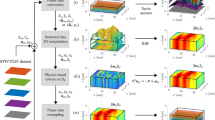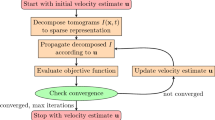Abstract
The error resulting from volumetric reconstructions of a transiting-model wake through a stationary stereo particle image velocimetry plane has been investigated. First, reconstruction error was evaluated analytically using two canonical, time-dependent flows representative of coherent structures typically found in turbulent wakes. The effects of sampling rate and structure parameters were investigated in reconstruction of a standing wave as well as a diffusing Lamb–Oseen vortex. Reconstruction error was found to be dependent on the length and time scales of these coherent structures, as well as the sampling rate of the measurement system itself. Subsequently, four non-dimensional groups were then identified to define the reconstruction error of these generalized flows. These non-dimensional groups can be used to assist in the design of experiments, by means of estimating error associated with reconstruction of transiting wakes. Finally, a transiting delta wing, travelling at Re \(=300{,}000\), was analyzed in the context of these aforementioned non-dimensional reconstruction parameters. Unsteady shear-layer interactions were found to incite the largest reconstruction error due to their fast temporal scales relative to the scanning speed.
Graphic abstract










Similar content being viewed by others
References
Brücker C (1995) Digital-particle-image-velocimetry DPIV in a scanning light-sheet: 3D starting flow around a short cylinder. Exp Fluids 19(4):255–263
Gan L, Nickels TB, Dawson JR (2011) An experimental study of a turbulent vortex ring: a three-dimensional representation. Exp Fluids 51(6):1493–1507
Huang RF, Lin CL (1995) Vortex shedding and shear-layer instability of wing at low-reynolds numbers. AIAA J 33(8):1398–1403
Hubel TY, Hristov NI, Swartz SM, Breuer KS (2009) Time-resolved wake structure and kinematics of bat flight. Exp Fluids 46(5):933–943
Ol MV, Gharib M (2003) Leading-edge vortex structure of nonslender delta wings at low Reynolds numbers. AIAA J 41:16–26
Pope S (2000) Turbulent flows, vol 12. Cambridge University Press, Cambridge
Reynolds O (1895) On the dynamical theory of incompressible viscous fluids and the determination of the criterion. Philos Trans R Soc Lond A Math Phys Eng Sci 186:123–164
Saffman PG (1992) Vortex dynamics. Cambridge University Press, Cambridge
Scarano F, van Wijk C, Veldhuis L (2002) Traversing field of view and AR-PIV for mid-field wake vortex investigation in a towing tank. Exp Fluids 33:950–961
Spoelstra A, de Martino Norante L, Terra W, Sciacchitano A, Scarano F (2018) An assessment of the ring of fire approach for indoor and outdoor on-site sports aerodynamic investigation. In: 19th international symposium on the application of laser and imaging techniques to fluid mechanics
Zaman KBMQ, Hussain AKMF (1981) Taylor hypothesis and large-scale coherent structures. J Fluid Mech 112:379–396
Zhou Y, Antonia RA (1992) Convection velocity measurements in a cylinder wake. Exp Fluids 13(1):63–70
Acknowledgements
The authors wish to thank Canadian Hydro Components Ltd., the Ontario Centres of Excellence (OCE), and the Natural Sciences and Engineering Research Council (NSERC) of Canada for their financial support through a joint VIP II/CRD Grant. M.M. and D.R. also acknowledge support for the delta-wing experiments through the United States Office of Naval Research (ONR) Grant no. N00014-16-1-2732.
Author information
Authors and Affiliations
Corresponding author
Additional information
Publisher's Note
Springer Nature remains neutral with regard to jurisdictional claims in published maps and institutional affiliations.
Rights and permissions
About this article
Cite this article
Bond, C., Marzanek, M.F., Neeteson, N.J. et al. On the volumetric reconstruction of transiting wakes using stereoscopic-PIV. Exp Fluids 60, 152 (2019). https://doi.org/10.1007/s00348-019-2802-6
Received:
Revised:
Accepted:
Published:
DOI: https://doi.org/10.1007/s00348-019-2802-6




